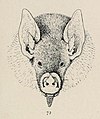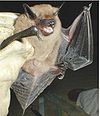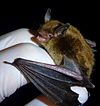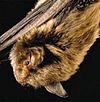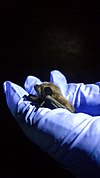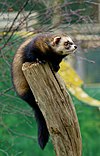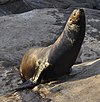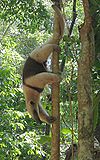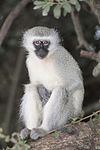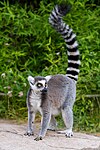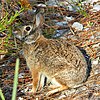List of mammals of Florida

This is a list ofmammal species found in the wild in the American state ofFlorida.One hundred sixteen species of mammals are known to inhabit, or have recently inhabited, the state and its surrounding waters. This includes a few species, such as theblack-tailed jackrabbitandred deer,that were introduced after thearrival of Europeans.It also includes the extinctCaribbean monk sealandFlorida black wolf.Rodents account for roughly one quarter of all species, followed closely by mammals from the familiesCetaceaandCarnivora.
The species included in this list are drawn from the work of theAmerican Society of Mammalogists(ASM), which compiled information from five different publications.[3]Information on the international conservation status of species has been drawn from theIUCN Red List.
Chiroptera
[edit]Of the bats listed below, thirteen are confirmed to be resident species - all of them are insectivorous. Eight species had very low numbers reported, and can be classified as accidental species: theIndiana bat,Jamaican fruit bat,buffy flower bat,Cuban flower bat,Cuban fig-eating bat,little brown bat,northern long-eared myotis,and thesilver-haired bat.[4]
Bats can be classified in two groups by their roosting habits: solitary-roosting and colony-roosting bats.
Solitary bats prefer to live in leaves, palm fronds, andSpanish moss.Resident bats in this category are theeastern red bat,thenorthern yellow bat,and theSeminole bat.Hoary batsare not considered residents, because they migrate toMexicoandSouth Americato spend the winter, but are considered a native species.[5]
The remaining species are considered to be colony-roosting bats. Darker than their solitary counterparts and less furry, these bats prefer to live under bridges, in tree holes or caves. Only three Florida species live in caves: theeastern pipistrelle,thegray batand thesoutheastern myotis.Florida has the highest concentration of southeastern myotis in the world.[5]
The greatest threat to bats in Florida is the disturbance or destruction of roost sites, due to eithervandalismorurban development.[5]
| Common name | Scientific name
authority |
ASMstate status and native range[3] | Red list |
|---|---|---|---|
| FamilyMolossidae:Free-tailed bats | |||
| Florida bonneted bat | Eumops floridanus (Allen, 1932) |
rare,endemicto southern Florida |
|
| Velvety free-tailed bat | Molossus molossus (Pallas, 1766) |
rare; Lower Keys |
|
| Mexican free-tailed bat | Tadarida brasiliensis (I. Geoffroy, 1824) |
common, statewide except for Keys | |
| FamilyMormoopidae | |||
| Antillean ghost-faced bat | Mormoops blainvillei (Leach, 1821) |
rare, Lower Keys only[9] |
|
| Ghost-faced bat | Mormoops megalophylla (Peters,1864) |
extirpated[11] |
|
| Pristine mustached bat | Pteronotus pristinus (Silva-Taboada, 1974) |
Extinct |
|
| FamilyPhyllostomidae:Leaf-nosed bats | |||
| Jamaican fruit bat | Artibeus jamaicensis (Leach, 1821) |
rare, Lower Keys only |
|
| Buffy flower bat | Erophylla sezekorni (Gundlach, 1860) |
rare; Lower Keys |
|
| Cuban flower bat | Phyllonycteris poeyi (Gundlach, 1860) |
rare; Lower Keys |
|
| Cuban fig-eating bat | Phyllops falcatus (Gray, 1839) |
rare; Lower Keys |
|
| FamilyVespertilionidae:Vesper bats | |||
| Rafinesque's big-eared bat | Corynorhinus rafinesquii Lesson, 1827 |
rare, statewide except southern tip of peninsula and Keys |
|
| Big brown bat | Eptesicus fuscus (Beauvois, 1796) |
common statewide except for Keys |
|
| Silver-haired bat | Lasionycteris noctivagans (La Conte, 1831) |
rare; known only from northSanta Rosa Countyand possibly northNassau County |
|
| Eastern red bat | Lasiurus borealis (Müller, 1776) |
uncommon; panhandle and northern quarter of peninsula | |
| Hoary bat | Lasiurus cinereus (Beauvois, 1796) |
uncommon, panhandle and northern half of peninsula |
|
| Northern yellow bat | Lasiurus intermedius H. Allen, 1862 |
common statewide except southern tip of peninsula and Keys |
|
| Seminole bat | Lasiurus seminolus (Rhoads, 1895) |
common, statewide except southern tip of peninsula and Keys | |
| Southeastern myotis | Myotis austroriparius (Rhoads, 1897) |
common; cave habitats in panhandle and, disjunct, northeastern and northcentral peninsula |
|
| Gray bat | Myotis griscens A.H. Howell, 1909 |
rare, known only from panhandle, Marianna area |
|
| Little brown bat | Myotis lucifugus (La Conte, 1831) |
rare, known only from panhandle and Okaloosa County |
|
| Northern long-eared myotis | Myotis septentrionalis (Trouessart, 1897) |
rare/accidental or possibly extirpated,[27]known only from panhandle, Marianna and Jackson counties |
|
| Indiana bat | Myotis sodalis Miller & Allen, 1922 |
rare, known only from panhandle, Marianna and Jackson counties |
|
| Evening bat | Nycticeius humeralis (Rafinesque, 1818) |
uncommon; panhandle and northern quarter of peninsula |
|
| Eastern pipistrelle | Perimyotis subflavus (F. Cuvier, 1832) |
uncommon; panhandle and northern half of peninsula |
|
Carnivorans
[edit]
Coyotesarrived in northern Florida in the 1970s as their natural range expanded. Illegal releases, as well as the extirpation of thered wolfandgray wolffrom the state, were factors in their occupation of the state. Coyotes are extremely adaptable, living in all types of forests and farms.[32]
Florida has two types of foxes. The nativegray foxcan be found in the United States almost anywhere, except the northern plains andRockies.It is sometimes confused with thered foxdue to having patches of red hair.[33]The red fox was introduced to Florida by hunting clubs, although it may have been native in the northern panhandle. Its preferred habitats are open areas, while the gray fox prefers woods.[34]
Red wolveswere once common throughout the southeastern US, including Florida. Extinct in the wild in 1980, it has been progressively introduced to selectnature preserves.The present population was introduced as part of this recovery program in 1997 to theSaint Vincent National Refuge;[35]once red wolf pups reach 18 months, they are relocated to theNorth Carolinaportion of the program.[36]A subspecies ofred wolf,theFlorida black wolf(Canis rufus floridanus) was also endemic to the state, but became extinct in the 19th century.
Bobcatsare well adapted to urban development and are not a conservation concern. They make their home inhammocks,forests or swamps.[37]
TheFlorida pantheris a population ofcougarsfound in Florida. It differs from other populations by having longer legs, a smaller size, and a shorter darker coat. The skull of the Florida panther is broader and flatter with highly arched nasal bones.[38]Reportedly only seventy adult animals are alive,[39]and a 1992 study estimated that the subspecies would become extinct between 2016 and 2055.[40]It was chosen in 1982 as the Florida state animal by the state's schoolchildren.[41]
Two of the eleven species ofskunkslive in Florida. Both theeastern spotted skunkand thestriped skunkcan be found statewide (except for the Keys).
Small populations of the Everglades mink (Neogale vison evergladensis), a subspecies ofAmerican mink,are encountered nearLake Okeechobee,and in theBig Cypress Swamp-Everglades National Parkarea.[42]
North American river ottersare a common sight close to freshwater streams in Florida. The population is increasing.[43]
Raccoonsare prevalent in the contiguous 48 states, including Florida. Adaptable to almost all kinds of habitats, they are among the few which actually benefit from human development, since food becomes more available. Attacks by predators like the bobcat cause minimum mortality, and the main reason for raccoon deaths is considered to be car accidents.[44]They are predators ofsea turtlenests.[45]
TheFlorida black bear(Ursus americanus floridanus) is a subspecies of the American black bear. Differences between subspecies are very small; the Florida black bear has a highly arched forehead and a long and narrow braincase.[46]Estimates for 2002 indicated the number of bears statewide to be between 2,000 and 3,200, indicating an increase from the previous census in 1998. The biggest cause of concern isroadkill,although the rates of mortality are equivalent to other areas in the country.[47]
Florida does not have seal colonies, but stray seals come ashore in Florida occasionally. The most prevalent of those have been thecommon sealand thehooded seal,although abearded sealwas seen in 2007.[48]TheCaribbean monk sealwas native to theCaribbean Seaand theGulf of Mexico.Once a popular prey forBahamasfishermen, their numbers diminished greatly in the 1800s. The last sighting of the species in Florida was in 1922, and specimens have not been seen anywhere since 1952.[49]
| Common name | Scientific name
authority |
ASMstate status and native range[3] | Red List |
|---|---|---|---|
| FamilyFelidae:Felines | |||
| Ocelot | Leopardus pardalis (Linnaeus, 1758) |
extirpated[50] |
|
| Bobcat | Lynx rufus (Schreber,1777) |
common; peninsula and northern Keys | |
| Jaguar | Panthera onca (Linnaeus, 1758) |
extirpated[52] |
|
| Florida panther | Puma concolor (Linnaeus,1771) |
endemic and rare; restricted to Green Swamp and Big Cypress areas in SW peninsula | |
| FamilyCanidae:Canines | |||
| Coyote | Canis latrans Say, 1823 |
uncommon or locally common statewide |
|
| Gray wolf | Canis lupus Linnaeus, 1758 |
extirpated[55] |
|
| Red wolf | Canis rufus (Audubon & Bachman, 1851) |
rare; introduced onSt. Vincent Island,extirpated elsewhere |
|
| Florida black wolf | C. r. floridanus Miller, 1912 |
extinct |
|
| Gray fox | Urocyon cinereoargenteus (Schreber, 1775) |
uncommon or locally common statewide |
|
| Red fox | Vulpes vulpes (Linnaeus,1758) |
uncommon or locally common statewide |
|
| FamilyUrsidae:Bears | |||
| Black bear | Ursus americanus (Pallas,1780) |
rare or uncommon; localized populations statewide except Keys |
|
| FamilyProcyonidae:Raccoons and allies | |||
| Kinkajou | Potos flavus (Schreber,1774) |
introduced[61] |
|
| Common raccoon | Procyon lotor (Linnaeus,1758) |
abundant, statewide |
|
| White-nosed coati | Nasua narica Linnaeus, 1766 |
introduced[64] |
|
| South American coati | Nasua nasua Linnaeus, 1766 |
introduced;Miami-Dade County[66] |
|
| FamilyMustelidae:Mustelids | |||
| Northern river otter | Lontra canadensis (Schreber, 1777) |
locally common, mostly freshwater habitats, primarily rivers and streams, statewide except Keys | |
| European polecat | Mustela putorius Linnaeus,1758 |
introduced[69] | |
| Long-tailed weasel | Neogale frenata (Lichtenstein,1831) |
rare; statewide exceptEvergladesand Keys |
|
| American mink | Neogale vison (Schreber, 1777) |
rare; coastal marshes in west Panhandle, Big Bend area, northeast area, and Everglades |
|
| American badger | Taxidea taxus (Schreber,1777) |
uncommon; Gulf coast[73] | |
| FamilyMephitidae:Skunks | |||
| American hog-nosed skunk | Conepatus leuconotus (Lichtenstein, 1832) |
extirpated[75] |
|
| Striped skunk | Mephitis mephitis (Schreber, 1776) |
common; statewide except Keys |
|
| Eastern spotted skunk | Spilogale putorius (Linnaeus, 1758) |
common; statewide except northeast corner and Keys |
|
| SuperfamilyPinnipedia:Pinnipeds | |||
| FamilyOtariidae:Eared seals | |||
| California sea lion | Zalophus californianus (Lesson, 1828) |
introduced; accidental sightings had occurred in Florida's Gulf coast of wandering individuals fromMobile Bay,Alabama[79] | |
| FamilyPhocidae:Earless seals | |||
| Hooded seal | Cystophora cristata (Erxleben, 1777) |
rare; east coastal marine areas toCentral Florida |
|
| Bearded seal | Erignathus barbatus (Erxleben, 1777) |
rare; east coastal marine areas to Central Florida |
|
| Caribbean monk seal | Neomonachus tropicalis (Erxleben, 1777) |
extinct |
|
| Gray seal | Halichoerus grypus (O. Fabricius,1791) |
rare[84] |
|
| Harbor seal | Phoca vitulina (Linnaeus,1758) |
rare; east coastal marine areas to Central Florida |
|
Cetaceans
[edit]
Of the several whales seen close to Florida, the most frequent and notable visitor is theNorth Atlantic right whale.Named as such because they were the "right" whales to kill, their only known calving ground is located off the coasts of Georgia and Florida. Pregnant females migrate from feeding grounds located far north and deliver calves from mid-December to March.[86]Humpback whalesare also re-colonizing the area whilegray whales,once cavorting off Florida for the same reasons as the right whales, were extirpated from the Atlantic in the 17th and 18th centuries.[87]
The most common dolphin in the state is thecommon bottlenose dolphin.Dolphins, like manatees, are vulnerable tored tideand have mass fatalities when one occurs.[88]Dolphins were designated the Florida state saltwater mammal in 1975.[89]
| Common name | Scientific name
authority |
ASMstate status and native range[3] | Red List | |
|---|---|---|---|---|
| FamilyBalaenidae:Right whales | ||||
| Southern right whale | Eubalaena australis (Desmoulins, 1822) |
vagrant; Atlantic coast[90] |
| |
| North Atlantic right whale | Eubalaena glacialis (Linnaeus,1758) |
regular migrant (in very small number) |
| |
| FamilyBalaenopteridae:Rorquals | ||||
| Common minke whale | Balaenoptera acutorostrata Lacépède, 1804 |
rare |
| |
| Sei whale | Balaenoptera borealis (Lesson,1828) |
rare |
| |
| Rice's whale | Balaenoptera ricei Rosel et al., 2021 |
resident |
| |
| Bryde's whale | Balaenoptera brydei Anderson, 1878 |
rare |
| |
| Blue whale | Balaenoptera musculus (Linnaeus,1758) |
rare |
| |
| Fin whale | Balaenoptera physalus (Linnaeus,1758) |
rare |
| |
| Humpback whale | Megaptera novaeangliae (Borowski, 1781) |
common (in small numbers) |
| |
| Family Eschrichtiidae: Gray whales | ||||
| Gray whale | Eschrichtius robustus (Lilljebor,1861) |
extirpated; however in December 2023, a rare sighting of the species was seen atSunny Isles Beach,which is considered to be the first rediscovered gray whale in Florida since the 18th century[100][101][102] |
| |
| Family Physeteridae: Sperm whales | ||||
| Sperm whale | Physeter macrocephalus (Linnaeus,1758) |
rare |
| |
| FamilyKogiidae:Dwarf sperm whales | ||||
| Pygmy sperm whale | Kogia breviceps (Blainville, 1838) |
uncommon |
| |
| Dwarf sperm whale | Kogia sima (Owen, 1866) |
uncommon |
| |
| FamilyZiphidae:Beaked whales | ||||
| Northern bottlenose whale | Hyperoodon ampullatus (Forster, 1770) |
rare; Atlantic coast[107] |
| |
| Sowerby's beaked whale | Mesoplodon bidens Sowerby, 1804 |
rare; Gulf coast[109] |
| |
| Blainville's beaked whale | Mesoplodon densirostris (Blainville, 1817) |
rare |
| |
| Gervais' beaked whale | Mesoplodon europaeus (Gervais, 1855) |
rare |
| |
| True's beaked whale | Mesoplodon mirus (True, 1913) |
rare; Atlantic coast south to Flagler County. |
| |
| Cuvier's beaked whale | Ziphius cavirostris (G. Cuvier,1823) |
rare | ||
| FamilyPhocoenidae:Porpoises | ||||
| Harbor porpoise | Phocoena phocoena (Linnaeus,1758) |
rare; east coastal marine areas toNorth Florida[115][116] |
| |
| FamilyDelphinidae:Oceanic dolphins | ||||
| Short-beaked common dolphin | Delphinus delphis (Gray, 1828) |
rare |
| |
| Pygmy killer whale | Feresa attenuata (Gray, 1875) |
rare |
| |
| Short-finned pilot whale | Globicephala macrorhynchus Gray, 1846 |
rare |
| |
| Risso's dolphin | Grampus griseus (G. Cuvier, 1812) |
rare |
| |
| Fraser's dolphin | Lagenodelphis hosei (Fraser, 1956) |
rare; |
| |
| Killer whale | Orcinus orca (Linnaeus,1758) |
rare though last sighting of the orcas where in theFlorida KeysoffKey Largoin July 2023.[123][124]& again spotted migrating from the coast ofFort PiercetoVero Beachon September 12, 2023.[125][126] |
| |
| Melon-headed whale | Peponocephala electra (Gray, 1846) |
rare |
| |
| False killer whale | Pseudorca crassidens (Owen, 1846) |
rare |
| |
| Pantropical spotted dolphin | Stenella attenuata (Gray, 1846) |
rare |
| |
| Clymene dolphin | Stenella clymene (Gray, 1846) |
rare |
| |
| Striped dolphin | Stenella coeruleoalba (Meyen, 1833) |
rare |
| |
| Atlantic spotted dolphin | Stenella frontalis (G. Cuvier, 1829) |
rare |
| |
| Spinner dolphin | Stenella longirostris (Gray, 1828) |
rare |
| |
| Rough-toothed dolphin | Steno bredanensis (G. Cuvier in Lesson, 1828) |
rare |
| |
| Common bottlenose dolphin | Tursiops truncatus (Montagu,1821) |
common; coastal |
| |
| Tamanend's bottlenose dolphin | Tursiops erebennus (Cope, 1865) |
rare; coastal |
| |
Even-toed ungulates
[edit]
The only native even-toed ungulate is thewhite-tailed deer.It is the most economically important hunting mammal in all of North America, and is one of the major prey animals of the Florida panther. There were only about 20,000 deer in Florida during the late 1930s, and the species was almost extinct in South Florida due to a campaign to eliminatetick-borne diseases.Hunt restraining measures and purchases from other states were very successful bringing the population to more than 700,000 deer statewide. A smaller subspecies, theKey deer,lives only in the Keys and numbers around 800 animals.[137]Sambar deerwere introduced in 1908 as alternative game for hunters on Saint Vincent Island. The population is between 700 and 1,000; 130 hunters are licensed per year, and each can kill up to two deer.[138]Somered deerwere released from a hunting ranch around 1967 and may still exist as a small herd.[139]
Wild boar found their way to Florida in 1539 with Spanish colonistHernando de Soto.Florida has 12% of the three million boars that roam in the US.[140]They are a popular hunting prey, but are regarded as a pest, due to the damage they inflict to agriculture and environment. More than 21,000 boar were killed in 1980 alone.[141]
| Common name | Scientific name authority |
ASMstate status and native range[3] | Red List | |
|---|---|---|---|---|
| FamilyCervidae:Deer | ||||
| Chital | Axis axis (Erxleben, 1777) |
introduced; uncommon |
| |
| Elk | Cervus canadensis (Erxleben,1777) |
introduced, possibly extirpated[143] |
| |
| Red deer | Cervus elaphus Linnaeus, 1758 |
introduced; single population inHighlands County[145] |
| |
| Sika deer | Cervus nippon Temminck,1838 |
introduced[147] |
| |
| White-tailed deer | Odocoileus virginianus (Zimmerman, 1780) |
common statewide; rare in Keys |
| |
| Key deer | O. v. clavium Barbour & G. M. Allen, 1922 |
only in Everglades or Keys |
| |
| Barasingha | Rucervus duvaucelii G. Cuvier,1823 |
introduced[150] |
| |
| Sambar deer | Rusa unicolor (Kerr,1792) |
introduced onSt. Vincent Island |
| |
| FamilyBovidae:Bovids | ||||
| American bison | Bison bison (Linnaeus,1758) |
reintroduced onPaynes Prairie Preserve[153][154][155] |
| |
| Nilgai | Boselaphus tragocamelus (Pallas,1766) |
introduced |
| |
| FamilySuidae:Pigs | ||||
| Common warthog | Phacochoerus africanus (Gmelin,1788) |
introduced[157] |
| |
| Wild boar | Sus scrofa Linnaeus, 1758 |
introduced; common |
| |
| FamilyAntilocapridae:Pronghorns | ||||
| Pronghorn | Antilocapra americana (Ord, 1815) |
introduced, presumably extirpated;Osceloa County[160] |
| |
| FamilyTayassuidae:Peccaries | ||||
| Collared peccary | Dicotyles tajacu (Linnaeus,1758) |
extirpated[162] |
| |
Marsupials
[edit]TheVirginia opossumis the onlymarsupialfound in North America north of theRio Grande.It lives in wooded areas and can be easily found statewide.
| Common name |
Scientific name authority |
ASMstate status and native range[3] | Red List | |
|---|---|---|---|---|
| Family Didelphidae: New World opossums | ||||
| Virginia opossum | Didelphis virginiana (Kerr, 1792) |
common; statewide |
| |
Armadillos
[edit]Cingulata are represented by thenine-banded armadillo,having migrated fromTexas.Subsequent introductions and fast breeding spread the species statewide.[141]
| Common name |
Scientific name authority |
ASMstate status and native range[3] | Red List | |
|---|---|---|---|---|
| Family Dasypodidae: Armadillos | ||||
| Nine-banded armadillo | Dasypus novemcinctus Linnaeus, 1758 |
common; statewide, except possibly some parts of Everglades |
| |
Anteaters and tamanduas
[edit]The Myrmecophagidae are a family ofanteaters,the name is derived from theAncient Greekwords for 'ant' and 'eat'. Two genera and three species are in the family, consisting of thegiant anteater,and thetamanduas.
| Common name |
Scientific name authority |
ASMstate status and native range[3] | Red List | |
|---|---|---|---|---|
| Family Myrmecophagidae | ||||
| Northern tamandua | Tamandua mexicana (Saussure,1860) |
introduced; Miami-Dade County[166] |
| |
Primates
[edit]Sixrhesus macaqueswere introduced sometime in the 1930s as tourist attractions, confined to an island in a Central Florida river and flourished.[168]Charles River Laboratories,the world's biggest producer of lab animals, maintained a free-range colony until 1999, when they were forced to remove the animals after they destroyed parts of themangroveforests inKey Haven.[169]Other primates with reported sightings not included in this list arecrab-eating macaquesandsquirrel monkeys.[170]
| Common name |
Scientific name authority |
ASMstate status and native range[3] | Red List | |
|---|---|---|---|---|
| Family Cercopithecidae: Old World monkeys | ||||
| Vervet monkey | Chlorocebus pygerythrus (F. Cuvier, 1821) |
introduced;Dania BeachandFort Lauderdalearea.[171] |
| |
| Rhesus macaque | Macaca mulatta (Zimmermann, 1780) |
introduced;OcalaandSilver Springsarea |
| |
| Family Lemuridae: Lemurs | ||||
| Ring-tailed lemur | Lemur catta Linnaeus,1758 |
introduced[174] |
| |
Lagomorphs
[edit]All the confirmedlagomorphsin Florida are nocturnal; theblack-tailed jackrabbit—introduced as a training tool for racinggreyhoundsfrom 1930 to 1950; the nativeeastern cottontail,which can be found anywhere but in forests and coastal marshes; and themarsh rabbit,which prefers freshwater andbrackish marshes.The subspeciesLower Keys marsh rabbithas the scientific nameSylvilagus palustris hefneriafterHugh Hefner—because research on the subspecies was financed in part by thePlayboy Foundation.[176]
| Common name | Scientific name
authority |
ASMstate status and native range[3] | Red List | |
|---|---|---|---|---|
| FamilyLeporidae:Rabbits and hares | ||||
| Black-tailed jackrabbit | Lepus californicus (Gray, 1837) |
introduced; established inHomesteadarea |
| |
| Swamp rabbit | Sylvilagus aquaticus (Bachman, 1837) |
rare and unconfirmed; possibly present in Escambia County but no known records |
| |
| Eastern cottontail | Sylvilagus floridanus (J. A. Allen, 1890) |
common; statewide except Keys |
| |
| Marsh rabbit | Sylvilagus palustris (Bachman, 1837) |
common; statewide |
| |
| Lower Keys marsh rabbit | S. p. hefneri (Lazell, 1984) |
Florida Keys | ||
Rodents
[edit]
Of the several species of rodents in Florida, the subspecies ofoldfield mouseare the biggest conservation concern, along with theFlorida mouseandFlorida salt marsh vole.Six of eight subspecies of the oldfield mouse (commonly namedbeach mice) are in endangered status, and one is extinct. Given causes for their demise is predators like cats and red foxes and destruction of their natural habitats.[181]The Florida mouse is on the endangered species list because of destruction of their habitat. The Florida bonneted bat, Florida mouse and Florida salt marsh vole are the only mammal speciesendemicto Florida. The mouse depends on thegopher tortoise(also endangered) for its survival, because it makes its burrows from tortoise burrows, or in the absence of those, oldfield mouse burrows.[182]
Non-native species brought in boats by colonizers are theblack rat,brown ratandhouse mouse.Other non-natives are thecapybara,thenutriaand theMexican gray squirrel.[183]
| Common name | Scientific name
authority |
ASMstate status and native range[3] | Red List | |
|---|---|---|---|---|
| FamilyCastoridae:Beavers | ||||
| American beaver | Castor canadensis (Kuhl,1820) |
common; panhandle and northern third of peninsula, except coastal areas. |
| |
| FamilySciuridae:Squirrels | ||||
| Southern flying squirrel | Glaucomys volans (Linnaeus,1758) |
common; statewide except Keys and possibly southwest peninsula |
| |
| Groundhog | Marmota monax (Linnaeus,1758) |
rare[186] |
| |
| Mexican gray squirrel | Sciurus aureogaster F. Cuvier, 1829 |
introduced; established onElliott Key |
| |
| Eastern gray squirrel | Sciurus carolinensis (Gmelin,1788) |
common; statewide except Lower Keys |
| |
| Fox squirrel | Sciurus niger (Linnaeus,1758) |
rare; statewide except Keys; possibly extinct in southeastern peninsula |
| |
| Eastern chipmunk | Tamias striatus (Linnaeus,1758) |
uncommon; northern half of western panhandle inmesic forestareas |
| |
| American red squirrel | Tamiasciurus hudsonicus (Erxleben, 1777) |
rare[192] |
| |
| FamilyGeomyidae:Pocket gophers | ||||
| Plains pocket gopher | Geomys bursarius (Shaw, 1800) |
rare[194] |
| |
| Southeastern pocket gopher | Geomys pinetis (Rafinesque, 1817) |
common; panhandle and northern half of peninsula |
| |
| Goff's pocket gopher | G. p. goffi Sherman, 1944 |
extinct; once endemic toBrevard County |
| |
| FamilyZapodidae:Jumping mice | ||||
| Woodland jumping mouse | Napaeozapus insignis (Miller, 1891) |
rare[197] |
| |
| FamilyCricetidae:Voles, muskrats | ||||
| Eastern harvest mouse | Reithrodontomys humulis (Audubon & Bachman, 1941) |
common; panhandle and northern two thirds of peninsula in old fields, grasslands, and fields |
| |
| Florida salt marsh vole | Microtus dukecampbelli (Woods, Post, and Kilpatrick, 1982) |
rare; endemic tosalt marshesinWaccasassa BayinLevy County | ||
| Woodland vole | Microtus pinetorum (Le Conte, 1830) |
uncommon; central portion of northern third of peninsula |
| |
| Round-tailed muskrat | Neofiber alleni (True, 1884) |
common; peninsula and isolated populations inApalachicolaand Okefenokee areas |
| |
| Florida woodrat | Neotoma floridana (Ord, 1818) |
uncommon; panhandle, northern two thirds of peninsula and rare; Key Largo |
| |
| Key Largo woodrat | Neotoma floridana smalli (Sherman, 1955) |
Endangered in Key Largo |
| |
| Golden mouse | Ochrotomys nuttalli (Harlan, 1832) |
rare; panhandle and northern half of peninsula |
| |
| Muskrat | Ondatra zibethicus (Linnaeus, 1766) |
common; northwestern half of panhandle |
| |
| Marsh rice rat | Oryzomys palustris (Harlan, 1837) |
common; statewide |
| |
| Cotton mouse | Peromyscus gossypinus (Le Conte, 1850) |
common; statewide in forests and mixed forest/grasslands |
| |
| Key Largo cotton mouse | P. g. allapaticola
(Schwartz, 1952) |
endemic toKey Largo | ||
| Chadwick Beach cotton mouse | P. g. restrictus
(A.H. Howell,1939) |
extinct; once endemic to the Chadwick Beach area ofManasota Key | ||
| Oldfield mouse | Peromyscus polionotus
(Wagner,1843) |
common; several endemic subspecies (see below) | ||
| Pallid beach mouse | P. p. decoloratus (A.H. Howell, 1939) |
extinct; once endemic to Ponce Park inVolusia Countyand Bulow inFlagler County |
| |
| Anastasia Island beach mouse | P. p. phasma (Bangs, 1898) |
endemic toAnastasia Islandin St. Augustine, Florida |
| |
| Perdido Key beach mouse | P. p. trissyllepsis (Bowen, 1968) |
endemic toPerdido Key,Florida |
| |
| Florida mouse | Podomys floridanus (Chapman, 1889) |
rare; central peninsula, mostly in habitats along central ridges. | ||
| Hispid cotton rat | Sigmodon hispidus Say & Ord, 1825 |
common; statewide |
| |
| FamilyMuridae:Murids | ||||
| House mouse | Mus musculus Linnaeus, 1758 |
introduced; common; statewide |
| |
| Brown rat | Rattus norvegicus (Berkenhout, 1769) |
introduced; common; statewide |
| |
| Black rat | Rattus rattus (Linnaeus, 1758) |
introduced; common statewide |
| |
| FamilyNesomyidae:Nesomyids | ||||
| Gambian pouched rat | Cricetomys gambianus Waterhouse,1840 |
introduced; Keys[213] |
| |
| FamilyMyocastoridae:Nutrias | ||||
| Nutria | Myocastor coypus (Molina, 1782) |
introduced;Duval Countyand panhandle populations; possibly established statewide except Keys |
| |
| FamilyCaviidae:Cavies | ||||
| Patagonian mara | Dolichotis patagonum (Zimmermann,1780) |
introduced[216] |
| |
| Capybara | Hydrochoerus hydrochaeris (Linnaeus,1766) |
introduced;[218]while no breeding population has been confirmed, sightings still occur. While it is considered an invasive species, some claim that it mayserve as a proxy of the Pleistocene species.[219] |
| |
| FamilyDasyproctidae:Agoutis and acouchis | ||||
| Red-rumped agouti | Dasyprocta leporina (Linnaeus,1766) |
introduced; Miami-Dade County[221] |
| |
Shrews and moles
[edit]Four species ofshrews(eulipotyphlans) are found across Florida. Two known subspecies are the Homosassa shrew (Sorex longirostris eionis) and Sherman's short-tailed shrew (Blarina carolinensis shermanii).[223]One of their main predators is the cat. Completing the Eulipotyphla are two species ofmoles.
| Common name | Scientific name
authority |
ASMstate status and native range[3] | Red List | |
|---|---|---|---|---|
| FamilySoricidae:Shrews | ||||
| Southern short-tailed shrew | Blarina carolinensis (Bachman, 1837) |
common; statewide except for Keys |
| |
| North American least shrew | Cryptotis parva (Say, 1823) |
common; statewide except for Keys |
| |
| Everglades short-tailed shrew | Blarina peninsulae (Merriam, 1895) |
common; peninsular |
| |
| Southeastern shrew | Sorex longirostris Bachman, 1837 |
uncommon; north, south through Central Florida |
| |
| FamilyTalpidae:Moles | ||||
| Star-nosed mole | Condylura cristata (Linnaeus,1758) |
rare;Okefenokee Swamparea and possibly inLeon County |
| |
| Eastern mole | Scalopus aquaticus (Linnaeus, 1758) |
common; statewide except for Keys |
| |
Sirenia
[edit]
Trichechus manatus latirostrisis one of the two subspecies of theWest Indian manatee.This herbivorous aquatic mammal lives in rivers, springs and shallow coastal waters. It was designated the state marine mammal in 1975[229]and is protected by federal and state laws. Threatened by habitat loss, entanglements in fishing gear and crab traps, or by being asphyxiated or crushed by canal locks and flood gates, the most common cause for manatee deaths is being struck by boats, which caused one quarter of all deaths recorded since 1974. In 2015, the statewide population was estimated at 6,063.[230]
| Common name | Scientific name
authority |
ASMstate status and native range[3] | Red List | |
|---|---|---|---|---|
| FamilySirenia:Sea cows | ||||
| West Indian manatee | Trichechus manatus (Linnaeus, 1758) |
rare; coastal marine areas, but not usually north of the Suwannee River in the Gulf of Mexico; enters rivers and connected springs common; peninsula and northern Keys. |
| |
See also
[edit]- List of amphibians of Florida
- List of birds of Florida
- List of fishes of Florida
- List of reptiles of Florida
- List of snakes of Florida
- List of invasive species in Florida
- List of invasive species in the Everglades
- Species reintroduction
- List of North American animals extinct in the Holocene
- Fauna of Florida
References
[edit]- General
- Brown, L. N. (1997).Mammals of Florida.Miami, Florida: Windward Publishing.
- Burt, W. H.; R. P. Grossenheider (1976).A field guide to the mammals of America north of Mexico(Third ed.). Boston: Houghton Mifflin Company.
- Nowak, R. M. (1991).Walker's mammals of the world(Fifth ed.). Baltimore, Maryland: The Johns Hopkins University Press.
- Stevenson, H. M. (1976).Vertebrates of Florida, identification and distribution(Fifth ed.). Gainesville, Florida: University Presses of Florida.
- Whitaker, J. O.; W. J. Hamilton (1998).Mammals of the Eastern United States(Third ed.). Ithaca, New York: Cornell University Press.
- "State Lists: Mammals of Florida".The American Society of Mammalogists. May 22, 2001. Archived fromthe originalon August 26, 2007.RetrievedJuly 18,2007.
- Specific
- ^ab"§15.038 2006 Florida Statutes".State of Florida.Archivedfrom the original on November 10, 2020.RetrievedJuly 19,2007.
- ^"§15.0353 2006 Florida Statutes".State of Florida.Archivedfrom the original on November 20, 2007.RetrievedJuly 19,2007.
- ^abcdefghijklm"State Lists: Mammals of Florida".The American Society of Mammalogist. May 22, 2001.Archivedfrom the original on December 19, 2012.RetrievedJuly 18,2007.The silver rice rat is not in this list because it was reclassified as asynonymof the marsh rice rat (Oryzomys palustris). Besides that, the classification for animals was updated to reflect current nomenclature, and the common names of animals changed to the names used in Wikipedia articles.
- ^"Accidental Bat Species in Florida".Florida Bat Conservancy. 2005. Archived fromthe originalon July 12, 2007.RetrievedJuly 19,2007.
- ^abcDenise R. Tomlinson."Florida's Bats".little publishing co.Archivedfrom the original on April 17, 2009.RetrievedJuly 19,2007.
- ^Solari, S. (2016),"Eumops floridanus",IUCN Red List of Threatened Species,2016:e.T136433A21984011,doi:10.2305/IUCN.UK.2016-1.RLTS.T136433A21984011.en
- ^Barquez, R.; Rodriguez, B.; Miller, B.; Diaz, M. (2015)."Molossus molossus".IUCN Red List of Threatened Species.2015:e.T13648A22106602.doi:10.2305/IUCN.UK.2015-4.RLTS.T13648A22106602.en.RetrievedNovember 20,2021.
- ^Barquez, R.; Diaz, M.; Gonzalez, E.; Rodriguez, A.; Incháustegui, S.; Arroyo-Cabrales, J. (2015)."Tadarida brasiliensis".IUCN Red List of Threatened Species.2015:e.T21314A22121621.doi:10.2305/IUCN.UK.2015-4.RLTS.T21314A22121621.en.RetrievedNovember 20,2021.
- ^"Mormoops blainvillei".Guide for Acoustic Identification of Florida bats.RetrievedFebruary 1,2023.
- ^Miller, B.; Reid, F.; Arroyo-Cabrales, J.; Cuarón, A.D.; de Grammont, P.C. (2016)."Mormoops blainvillei".IUCN Red List of Threatened Species.2016:e.T13877A22085914.doi:10.2305/IUCN.UK.2016-2.RLTS.T13877A22085914.en.RetrievedNovember 15,2021.
- ^Rezsutek, Michael; Cameron, Guy N. (November 15, 1993)."Mormoops megalophylla".Mammalian Species(448): 1–5.doi:10.2307/3504289.JSTOR3504289.
- ^Davalos, L.; Molinari, J.; Mantilla-Meluk, H.; Medina, C.; Pineda, J.; Rodriguez, B. (2019)."Mormoops megalophylla".IUCN Red List of Threatened Species.2019:e.T13878A22086060.doi:10.2305/IUCN.UK.2019-1.RLTS.T13878A22086060.en.RetrievedSeptember 9,2023.
- ^Miller, B.; Reid, F.; Arroyo-Cabrales, J.; Cuarón, A.D.; de Grammont, P.C. (2016)."Artibeus jamaicensis".IUCN Red List of Threatened Species.2016:e.T88109731A21995883.doi:10.2305/IUCN.UK.2016-3.RLTS.T88109731A21995883.en.RetrievedNovember 20,2021.
- ^Mancina, C.; Davalos, L. (2019)."Erophylla sezekorni".IUCN Red List of Threatened Species.2019:e.T8033A22106213.doi:10.2305/IUCN.UK.2019-1.RLTS.T8033A22106213.en.RetrievedNovember 16,2021.
- ^Mancina, C.; Solari, S. (2019)."Phyllonycteris poeyi".IUCN Red List of Threatened Species.2019:e.T17175A22133601.doi:10.2305/IUCN.UK.2019-1.RLTS.T17175A22133601.en.RetrievedAugust 24,2022.
- ^Solari, S.; Mancina, C.; Davalos, L. (2019)."Phyllops falcatus".IUCN Red List of Threatened Species.2019:e.T17176A22133485.doi:10.2305/IUCN.UK.2019-1.RLTS.T17176A22133485.en.RetrievedNovember 16,2021.
- ^Arroyo-Cabrales, J.; Álvarez-Castañeda, S.T. (2017)."Corynorhinus rafinesquii".IUCN Red List of Threatened Species.2017:e.T17600A21976905.doi:10.2305/IUCN.UK.2017-2.RLTS.T17600A21976905.en.RetrievedNovember 20,2021.
- ^Miller, B.; Reid, F.; Arroyo-Cabrales, J.; Cuarón, A.D.; de Grammont, P.C. (2016)."Eptesicus fuscus".IUCN Red List of Threatened Species.2016:e.T7928A22118197.doi:10.2305/IUCN.UK.2016-3.RLTS.T7928A22118197.en.RetrievedNovember 20,2021.
- ^Solari, S. (2019)."Lasionycteris noctivagans".IUCN Red List of Threatened Species.2019:e.T11339A22122128.doi:10.2305/IUCN.UK.2019-1.RLTS.T11339A22122128.en.RetrievedNovember 20,2021.
- ^Arroyo-Cabrales, J.; Miller, B.; Reid, F.; Cuarón, A.D.; de Grammont, P.C. (2016)."Lasiurus borealis".IUCN Red List of Threatened Species.2016:e.T11347A22121017.doi:10.2305/IUCN.UK.2016-1.RLTS.T11347A22121017.en.RetrievedNovember 20,2021.
- ^Gonzalez, E.; Barquez, R.; Arroyo-Cabrales, J. (2016)."Lasiurus cinereus".IUCN Red List of Threatened Species.2016:e.T11345A22120305.doi:10.2305/IUCN.UK.2016-1.RLTS.T11345A22120305.en.RetrievedNovember 20,2021.
- ^Chiroptera Specialist Group (1996)."Lasiurus intermedius".IUCN Red List of Threatened Species.1996.RetrievedJuly 19,2007.
- ^Solari, S. (2019)."Lasiurus seminolus".IUCN Red List of Threatened Species.2019:e.T11353A22119113.doi:10.2305/IUCN.UK.2019-1.RLTS.T11353A22119113.en.RetrievedNovember 20,2021.
- ^Arroyo-Cabrales, J.; Álvarez-Castañeda, S.T. (2017)."Myotis austroriparius".IUCN Red List of Threatened Species.2017:e.T14147A22059907.doi:10.2305/IUCN.UK.2017-2.RLTS.T14147A22059907.en.RetrievedNovember 20,2021.
- ^Solari, S. (2018)."Myotis grisescens".IUCN Red List of Threatened Species.2018:e.T14132A22051652.doi:10.2305/IUCN.UK.2018-2.RLTS.T14132A22051652.en.RetrievedNovember 20,2021.
- ^Solari, S. (2018)."Myotis lucifugus".IUCN Red List of Threatened Species.2018:e.T14176A22056344.doi:10.2305/IUCN.UK.2018-2.RLTS.T14176A22056344.en.RetrievedNovember 20,2021.
- ^"NatureServe Explorer 2.0".explorer.natureserve.org.RetrievedDecember 7,2022.
- ^Solari, S. (2018)."Myotis septentrionalis".IUCN Red List of Threatened Species.2018:e.T14201A22064312.doi:10.2305/IUCN.UK.2018-2.RLTS.T14201A22064312.en.RetrievedNovember 20,2021.
- ^Arroyo-Cabrales, J.; Ospina-Garces, S. (2016)."Myotis sodalis".IUCN Red List of Threatened Species.2016:e.T14136A22053184.doi:10.2305/IUCN.UK.2016-1.RLTS.T14136A22053184.en.RetrievedNovember 20,2021.
- ^Solari, S. (2019)."Nycticeius humeralis".IUCN Red List of Threatened Species.2019:e.T14944A22015223.doi:10.2305/IUCN.UK.2019-1.RLTS.T14944A22015223.en.RetrievedNovember 20,2021.
- ^Solari, S. (2018)."Perimyotis subflavus".IUCN Red List of Threatened Species.2018:e.T17366A22123514.doi:10.2305/IUCN.UK.2018-2.RLTS.T17366A22123514.en.RetrievedNovember 20,2021.
- ^"Coyote".State of Florida. Archived fromthe originalon April 20, 2006.RetrievedJuly 19,2007.
- ^"Gray Fox".State of Florida. Archived fromthe originalon April 28, 2006.RetrievedJuly 19,2007.
- ^"Red Fox".State of Florida. August 2006. Archived fromthe originalon April 23, 2006.RetrievedJuly 19,2007.
- ^"Public Hearing Scheduled on Expanding Red Wolf Program to Northwest Florida's Little George Island".U.S. Fish and Wildlife Service. February 4, 1997.Archivedfrom the original on November 10, 2012.RetrievedJuly 19,2007.
- ^U.S. Fish & Wildlife Service."St. Vincent National Wildlife Refuge Fish, Amphibian, Reptile and Mammal List"(PDF).Archived(PDF)from the original on November 10, 2012.RetrievedJuly 19,2007.
- ^"Bobcat".State of Florida. August 2006. Archived fromthe originalon April 20, 2006.RetrievedJuly 19,2007.
- ^"Physical description".State of Florida. Archived fromthe originalon April 19, 2005.RetrievedJuly 19,2007.
- ^"Range of the Panther".State of Florida. Archived fromthe originalon June 30, 2007.RetrievedJuly 19,2007.
- ^"Inbreeding".State of Florida. Archived fromthe originalon September 7, 2005.RetrievedJuly 19,2007.
- ^"1980".State of Florida. Archived fromthe originalon September 6, 2005.RetrievedJuly 19,2007.
- ^"Mustela Vison".USDA Forest Service. Archived fromthe originalon June 26, 2007.
- ^"Lutra Canadensis".USDA Forest Service. Archived fromthe originalon June 26, 2007.RetrievedJuly 19,2007.
- ^"Raccoons".University of Florida.Archivedfrom the original on August 16, 2007.RetrievedJuly 19,2007.
- ^"2003 Florida Sea Turtle Nesting Trends & News from the Archie Carr Refuge".Caribbean Conservation Corporation. Archived fromthe originalon July 13, 2007.RetrievedJuly 19,2007.
- ^"The" Bear "Facts - Appearance".State of Florida.Archivedfrom the original on September 27, 2007.RetrievedJuly 19,2007.
- ^"Statewide Assessment of Road Impacts on Bears in Six Study Areas in Florida from May 2001 - September 2003"(PDF).State of Florida.Archived(PDF)from the original on February 8, 2012.RetrievedJuly 19,2007.
- ^United Press International (May 5, 2007)."Bearded seal strays from Arctic to Florida".Science Daily. Archived fromthe originalon September 30, 2007.RetrievedJuly 19,2007.
- ^Animals (November–December 1997)."Ghost of a monk seal: has the Caribbean monk seal barked its final good-bye?".FindArticles. Archived fromthe originalon October 6, 2008.RetrievedJuly 19,2007.
- ^Murray, Julie L.; Gardner, Gregory L. (May 9, 1997). "Leopardus pardalis".Mammalian Species(548): 1–10.doi:10.2307/3504082.JSTOR3504082.
- ^Paviolo, A.; Crawshaw, P.; Caso, A.; de Oliveira, T.; Lopez-Gonzalez, C.A.; Kelly, M.; De Angelo, C. & Payan, E. (2016) [errata version of 2015 assessment]."Leopardus pardalis".IUCN Red List of Threatened Species.2015:e.T11509A97212355.doi:10.2305/IUCN.UK.2015-4.RLTS.T11509A50653476.en.RetrievedSeptember 9,2023.
- ^"Jaguar Facts – Interesting Information About Jaguars".Big Cat Rescue.July 17, 2023.RetrievedSeptember 9,2023.
- ^Quigley, H.; Foster, R.; Petracca, L.; Payan, E.; Salom, R. & Harmsen, B. (2018) [errata version of 2017 assessment]."Panthera onca".IUCN Red List of Threatened Species.2017:e.T15953A123791436.doi:10.2305/IUCN.UK.2017-3.RLTS.T15953A50658693.en.RetrievedSeptember 9,2023.
- ^Kays, R. (2018)."Canis latrans".IUCN Red List of Threatened Species.2018:e.T3745A163508579.doi:10.2305/IUCN.UK.2018-2.RLTS.T3745A163508579.en.RetrievedNovember 20,2021.
- ^"NatureServe Explorer 2.0".explorer.natureserve.org.RetrievedSeptember 9,2023.
- ^Boitani, L.; Phillips, M.; Jhala, Y. (2018)."Canis lupus".IUCN Red List of Threatened Species.2018:e.T3746A163508960.doi:10.2305/IUCN.UK.2018-2.RLTS.T3746A163508960.en.RetrievedSeptember 9,2023.
- ^Phillips, M. (2018)."Canis rufus".IUCN Red List of Threatened Species.2018:e.T3747A163509841.doi:10.2305/IUCN.UK.2018-2.RLTS.T3747A163509841.en.RetrievedNovember 20,2021.
- ^Roemer, G.; Cypher, B.; List, R. (2016)."Urocyon cinereoargenteus".IUCN Red List of Threatened Species.2016:e.T22780A46178068.doi:10.2305/IUCN.UK.2016-1.RLTS.T22780A46178068.en.RetrievedNovember 20,2021.
- ^Hoffmann, M.; Sillero-Zubiri, C. (2021)."Vulpes vulpes".IUCN Red List of Threatened Species.2021:e.T23062A193903628.doi:10.2305/IUCN.UK.2021-1.RLTS.T23062A193903628.en.RetrievedNovember 20,2021.
- ^Bear Specialist Group (1996)."Ursus americanus".IUCN Red List of Threatened Species.1996.RetrievedJuly 19,2007.
- ^"Kinkajou".EDDMapS.RetrievedSeptember 18,2023.
- ^Helgen, K.; Kays, R.; Schipper, J. (2016)."Potos flavus".IUCN Red List of Threatened Species.2016:e.T41679A45215631.doi:10.2305/IUCN.UK.2016-1.RLTS.T41679A45215631.en.RetrievedSeptember 18,2023.
- ^Timm, R.; Cuarón, A.D.; Reid, F.; Helgen, K.; González-Maya, J.F. (2016)."Procyon lotor".IUCN Red List of Threatened Species.2016:e.T41686A45216638.doi:10.2305/IUCN.UK.2016-1.RLTS.T41686A45216638.en.RetrievedNovember 20,2021.
- ^"White-nosed coati".EDDMapS.RetrievedOctober 1,2023.
- ^Cuarón, A.D.; Helgen, K.; Reid, F.; Pino, J.; González-Maya, J.F. (2016)."Nasua narica".IUCN Red List of Threatened Species.2016:e.T41683A45216060.doi:10.2305/IUCN.UK.2016-1.RLTS.T41683A45216060.en.RetrievedOctober 1,2023.
- ^"South American coati".EDDMapS.RetrievedSeptember 18,2023.
- ^Emmons, L.; Helgen, K. (2016)."Nasua nasua".IUCN Red List of Threatened Species.2016:e.T41684A45216227.doi:10.2305/IUCN.UK.2016-1.RLTS.T41684A45216227.en.RetrievedSeptember 18,2023.
- ^Serfass, T.; Evans, S.S.; Polechla, P. (2015)."Lontra canadensis".IUCN Red List of Threatened Species.2015:e.T12302A21936349.doi:10.2305/IUCN.UK.2015-2.RLTS.T12302A21936349.en.RetrievedNovember 20,2021.
- ^"European Polecat".EDDMapS.RetrievedSeptember 19,2023.
- ^Skumatov, D.; Abramov, A.V.; Herrero, J.; Kitchener, A.; Maran, T.; Kranz, A.; Sándor, A.; Saveljev, A.; Savouré-Soubelet, A.; Guinot-Ghestem, M.; Zuberogoitia, I.; Birks, J.D.S.; Weber, A.; Melisch, R.; Ruette, S. (2016)."Mustela putorius".IUCN Red List of Threatened Species.2016:e.T41658A45214384.doi:10.2305/IUCN.UK.2016-1.RLTS.T41658A45214384.en.RetrievedSeptember 19,2023.
- ^Helgen, K.; Reid, F. (2016)."Mustela frenata".IUCN Red List of Threatened Species.2016:e.T41654A45213820.doi:10.2305/IUCN.UK.2016-1.RLTS.T41654A45213820.en.RetrievedNovember 20,2021.
- ^Reid, F.; Schiaffini, M.; Schipper, J. (2016)."Neovison vison".IUCN Red List of Threatened Species.2016:e.T41661A45214988.doi:10.2305/IUCN.UK.2016-1.RLTS.T41661A45214988.en.RetrievedNovember 20,2021.
- ^"Badgers Thriving in Florida: An Insight into their Habitat and Population Growth".HummingbirdsPlus.RetrievedSeptember 23,2023.
- ^Helgen, K.; Reid, F. (2016)."Taxidea taxus".IUCN Red List of Threatened Species.2016:e.T41663A45215410.doi:10.2305/IUCN.UK.2016-1.RLTS.T41663A45215410.en.RetrievedSeptember 23,2023.
- ^Dragoo, Jerry W.; Sheffield, Steven R. (February 26, 2009). "Conepatus leuconotus(Carnivora: Mephitidae) ".Mammalian Species(827): 1–8.doi:10.1644/827.1.
- ^Helgen, K. (2016)."Conepatus leuconotus".IUCN Red List of Threatened Species.2016:e.T41632A45210809.doi:10.2305/IUCN.UK.2016-1.RLTS.T41632A45210809.en.RetrievedSeptember 9,2023.
- ^Helgen, K.; Reid, F. (2016)."Mephitis mephitis".IUCN Red List of Threatened Species.2016:e.T41635A45211301.doi:10.2305/IUCN.UK.2016-1.RLTS.T41635A45211301.en.RetrievedNovember 20,2021.
- ^Gompper, M.; Jachowski, D. (2016)."Spilogale putorius".IUCN Red List of Threatened Species.2016:e.T41636A45211474.doi:10.2305/IUCN.UK.2016-1.RLTS.T41636A45211474.en.RetrievedNovember 13,2021.
- ^Gunter, Gordon (1968)."The Status of Seals in the Gulf of Mexico with A Record of Feral Otariid Seals Off the United States Gulf Coast".Gulf Research Reports.2.doi:10.18785/grr.0203.05.
- ^Aurioles-Gamboa, D.; Hernández-Camacho, J. (2015)."Zalophus californianus".IUCN Red List of Threatened Species.2015:e.T41666A45230310.doi:10.2305/IUCN.UK.2015-4.RLTS.T41666A45230310.en.RetrievedSeptember 23,2023.
- ^Kovacs, K.M. (2016)."Cystophora cristata".IUCN Red List of Threatened Species.2016:e.T6204A45225150.doi:10.2305/IUCN.UK.2016-1.RLTS.T6204A45225150.en.RetrievedNovember 20,2021.
- ^"Bearded Seal".Archivedfrom the original on February 17, 2020.RetrievedOctober 15,2018.
- ^Lowry, L. (2015)."Neomonachus tropicalis".IUCN Red List of Threatened Species.2015:e.T13655A45228171.doi:10.2305/IUCN.UK.2015-2.RLTS.T13655A45228171.en.RetrievedNovember 20,2021.
- ^Hamblin, Larissa (March 26, 2019)."Gray seal found in Florida rescued from beach".Click Orlando.Flagler County, Florida.RetrievedMarch 19,2024.
- ^Lowry, L. (2016)."Phoca vitulina".IUCN Red List of Threatened Species.2016:e.T17013A45229114.doi:10.2305/IUCN.UK.2016-1.RLTS.T17013A45229114.en.RetrievedNovember 20,2021.
- ^"North Atlantic Right Whales".Fish and Wildlife Research Institute. Archived fromthe originalon May 13, 2001.RetrievedJuly 21,2007.
- ^Mead JG, Mitchell ED (1984). "Atlantic gray whales". In Jones ML, Swartz SL, Leatherwood S (eds.).The Gray Whale.London: Academic Press. pp. 33–53.
- ^"Red Tide Toxins Pose Lingering Threat to Marine Mammals".August 4, 2005. Archived fromthe originalon November 26, 2006.RetrievedJuly 21,2007.
- ^"State Symbols".The Florida Legislature. Archived fromthe originalon July 7, 2007.RetrievedJuly 21,2007.
- ^"Eubalaena australis".GBIF.RetrievedOctober 13,2023.
- ^Cooke, J.G.; Zerbini, A.N. (2018)."Eubalaena australis".IUCN Red List of Threatened Species.2018:e.T8153A50354147.doi:10.2305/IUCN.UK.2018-1.RLTS.T8153A50354147.en.RetrievedOctober 13,2023.
- ^Cooke, J.G. (2020)."Eubalaena glacialis".IUCN Red List of Threatened Species.2020:e.T41712A162001243.RetrievedJuly 9,2020.
- ^Cooke, J.G. (2018)."Balaenoptera acutorostrata".IUCN Red List of Threatened Species.2018:e.T2474A50348265.doi:10.2305/IUCN.UK.2018-2.RLTS.T2474A50348265.en.RetrievedNovember 20,2021.
- ^Cooke, J.G. (2018)."Balaenoptera borealis".IUCN Red List of Threatened Species.2018:e.T2475A130482064.doi:10.2305/IUCN.UK.2018-2.RLTS.T2475A130482064.en.RetrievedNovember 20,2021.
- ^Corkeron, P.; Reeves, R.; Rosel, P. (2017)."Balaenoptera edeni(Gulf of Mexico subpopulation) ".The IUCN Red List of Threatened Species.2017:e.T117636167A117636174.doi:10.2305/IUCN.UK.2017-3.RLTS.T117636167A117636174.en.
- ^Cooke, J.G.; Brownell Jr.; R.L. (2018)."Balaenoptera edeni".IUCN Red List of Threatened Species.2018:e.T2476A50349178.doi:10.2305/IUCN.UK.2018-1.RLTS.T2476A50349178.en.RetrievedNovember 20,2021.
- ^Cooke, J.G. (2018)."Balaenoptera musculus".IUCN Red List of Threatened Species.2018:e.T2477A156923585.doi:10.2305/IUCN.UK.2018-2.RLTS.T2477A156923585.en.RetrievedNovember 20,2021.
- ^Cooke, J.G. (2018)."Balaenoptera physalus".IUCN Red List of Threatened Species.2018:e.T2478A50349982.doi:10.2305/IUCN.UK.2018-2.RLTS.T2478A50349982.en.RetrievedNovember 20,2021.
- ^Cooke, J.G. (2018)."Megaptera novaeangliae".IUCN Red List of Threatened Species.2018:e.T13006A50362794.doi:10.2305/IUCN.UK.2018-2.RLTS.T13006A50362794.en.RetrievedNovember 20,2021.
- ^McCloud, Cheryl; Crowley, Kinsey (December 21, 2023)."Gray whale spotted off Florida coast. Here's why the sighting is so unusual".The Palm Beach Post.RetrievedDecember 21,2023.
- ^Kulo, Warren (December 22, 2023)."Video captures father, son encountering rare gray whale off Florida coast".AL.RetrievedDecember 22,2023.
- ^Rodriguez, Gabi (December 19, 2023)."Extremely rare and 'special' whale sighting near South Florida coast".NBC 6 South Florida.Sunny Isles Beach.RetrievedDecember 19,2023.
- ^Cooke, J.G. (2018)."Eschrichtius robustus".IUCN Red List of Threatened Species.2018:e.T8097A50353881.doi:10.2305/IUCN.UK.2018-2.RLTS.T8097A50353881.en.RetrievedNovember 20,2021.
- ^Taylor, B.L.; Baird, R.; Barlow, J.; Dawson, S.M.; Ford, J.; Mead, J.G.; Notarbartolo di Sciara, G.; Wade, P.; Pitman, R.L. (2019)."Physeter macrocephalus".IUCN Red List of Threatened Species.2019:e.T41755A160983555.doi:10.2305/IUCN.UK.2008.RLTS.T41755A160983555.en.RetrievedNovember 20,2021.
- ^Kiszka, J.; Braulik, G. (2020)."Kogia breviceps".IUCN Red List of Threatened Species.2020:e.T11047A50358334.doi:10.2305/IUCN.UK.2020-2.RLTS.T11047A50358334.en.RetrievedNovember 20,2021.
- ^Kiszka, J.; Braulik, G. (2020)."Kogia sima".IUCN Red List of Threatened Species.2020:e.T11048A50359330.doi:10.2305/IUCN.UK.2020-2.RLTS.T11048A50359330.en.RetrievedNovember 20,2021.
- ^"North Atlantic Bottlenose Whale".Observation.org.RetrievedFebruary 10,2024.
- ^Whitehead, H.; Reeves, R.; Feyrer, L.; Brownell Jr., R.L. (2021)."Hyperoodon ampullatus".IUCN Red List of Threatened Species.2021:e.T10707A50357742.doi:10.2305/IUCN.UK.2021-1.RLTS.T10707A50357742.en.RetrievedFebruary 10,2024.
- ^Delestre, R. J. R.; Lopez, M. A. R.; Giannoni, A. A. M.; Mead, J. G. (1999)."New Records of Beaked Whales (Mesoplodon spp.) for the Caribbean"(PDF).Caribbean Journal of Science.35(1–2): 144–148.
- ^Pitman, R.L.; Brownell Jr.; R.L. (2020)."Mesoplodon bidens".IUCN Red List of Threatened Species.2020:e.T13241A50363686.doi:10.2305/IUCN.UK.2020-3.RLTS.T13241A50363686.en.RetrievedNovember 18,2021.
- ^Pitman, R.L.; Brownell Jr.; R.L. (2020)."Mesoplodon densirostris".IUCN Red List of Threatened Species.2020:e.T13244A50364253.doi:10.2305/IUCN.UK.2020-3.RLTS.T13244A50364253.en.RetrievedNovember 20,2021.
- ^Pitman, R.L.; Brownell Jr.; R.L. (2020)."Mesoplodon europaeus".IUCN Red List of Threatened Species.2020:e.T13245A50365198.doi:10.2305/IUCN.UK.2020-3.RLTS.T13245A50365198.en.RetrievedNovember 20,2021.
- ^Pitman, R.L.; Brownell Jr.; R.L. (2020)."Mesoplodon mirus".IUCN Red List of Threatened Species.2020:e.T13250A50367095.doi:10.2305/IUCN.UK.2020-3.RLTS.T13250A50367095.en.RetrievedNovember 20,2021.
- ^Baird, R.W.; Brownell Jr.; R.L.; Taylor, B.L. (2020)."Ziphius cavirostris".IUCN Red List of Threatened Species.2020:e.T23211A50379111.doi:10.2305/IUCN.UK.2020-3.RLTS.T23211A50379111.en.RetrievedNovember 20,2021.
- ^"Harbour Porpoise".Animal Corner.RetrievedSeptember 23,2023.
- ^Marine Mammals: Shared Nordic Marine Stocks.Nordic Council of Ministers. 1994. p. 49.ISBN9-7892-9120-4298.
- ^Braulik, G.; Minton, G.; Amano, M.; Bjørge, A. (2020)."Phocoena phocoena".IUCN Red List of Threatened Species.2020:e.T17027A50369903.doi:10.2305/IUCN.UK.2020-2.RLTS.T17027A50369903.en.RetrievedSeptember 23,2023.
- ^Braulik, G.; Jefferson, T.A.; Bearzi, G. (2021)."Delphinus delphis".IUCN Red List of Threatened Species.2021:e.T134817215A199893039.doi:10.2305/IUCN.UK.2021-2.RLTS.T134817215A199893039.en.RetrievedNovember 20,2021.
- ^Braulik, G. (2018)."Feresa attenuata".IUCN Red List of Threatened Species.2018:e.T8551A50354433.doi:10.2305/IUCN.UK.2018-2.RLTS.T8551A50354433.en.RetrievedNovember 20,2021.
- ^Minton, G.; Braulik, G.; Reeves, R. (2018)."Globicephala macrorhynchus".IUCN Red List of Threatened Species.2018:e.T9249A50355227.doi:10.2305/IUCN.UK.2018-2.RLTS.T9249A50355227.en.RetrievedNovember 20,2021.
- ^Kiszka, J.; Braulik, G. (2018)."Grampus griseus".IUCN Red List of Threatened Species.2018:e.T9461A50356660.doi:10.2305/IUCN.UK.2018-2.RLTS.T9461A50356660.en.RetrievedNovember 20,2021.
- ^Kiszka, J.; Braulik, G. (2018)."Lagenodelphis hosei".IUCN Red List of Threatened Species.2018:e.T11140A50360282.doi:10.2305/IUCN.UK.2018-2.RLTS.T11140A50360282.en.RetrievedNovember 20,2021.
- ^"South Florida's newest tourists make a splash – exactly how rare was that orca sighting in Key Largo?".July 27, 2023.
- ^https:// miamiherald /news/local/community/florida-keys/article277603588.html[bare URL]
- ^"Orca whales spotted off the coast of Fort Pierce".WPBF.September 15, 2023.
- ^"Fort Pierce fisherman spots pods of orcas migrating off Vero Beach".WPTV News Channel 5 West Palm.September 12, 2023.
- ^Reeves, R.; Pitman, R.L.; Ford, J.K.B. (2017)."Orcinus orca".IUCN Red List of Threatened Species.2017:e.T15421A50368125.doi:10.2305/IUCN.UK.2017-3.RLTS.T15421A50368125.en.RetrievedNovember 20,2021.
- ^Cetacean Specialist Group (1996)."Peponocephala electra".IUCN Red List of Threatened Species.1996.RetrievedFebruary 24,2020.
- ^Baird, R.W. (2018)."Pseudorca crassidens".IUCN Red List of Threatened Species.2018:e.T18596A145357488.doi:10.2305/IUCN.UK.2018-2.RLTS.T18596A145357488.en.RetrievedNovember 20,2021.
- ^Kiszka, J.; Braulik, G. (2018)."Stenella attenuata".IUCN Red List of Threatened Species.2018:e.T20729A50373009.doi:10.2305/IUCN.UK.2018-2.RLTS.T20729A50373009.en.RetrievedNovember 20,2021.
- ^Jefferson, T.A.; Braulik, G. (2018)."Stenella clymene".IUCN Red List of Threatened Species.2018:e.T20730A50373865.doi:10.2305/IUCN.UK.2018-2.RLTS.T20730A50373865.en.RetrievedNovember 20,2021.
- ^Braulik, G. (2019)."Stenella coeruleoalba".IUCN Red List of Threatened Species.2019:e.T20731A50374282.doi:10.2305/IUCN.UK.2019-1.RLTS.T20731A50374282.en.RetrievedNovember 20,2021.
- ^Braulik, G.; Jefferson, T.A. (2018)."Stenella frontalis".IUCN Red List of Threatened Species.2018:e.T20732A50375312.doi:10.2305/IUCN.UK.2018-2.RLTS.T20732A50375312.en.RetrievedNovember 20,2021.
- ^Braulik, G.; Reeves, R. (2018)."Stenella longirostris".IUCN Red List of Threatened Species.2018:e.T20733A156927622.doi:10.2305/IUCN.UK.2018-2.RLTS.T20733A156927622.en.RetrievedNovember 20,2021.
- ^Kiszka, J.; Baird, R.; Braulik, G. (2019)."Steno bredanensis".IUCN Red List of Threatened Species.2019:e.T20738A178929751.doi:10.2305/IUCN.UK.2019-2.RLTS.T20738A178929751.en.RetrievedNovember 20,2021.
- ^Wells, R.S.; Natoli, A.; Braulik, G. (2019)."Tursiops truncatus".IUCN Red List of Threatened Species.2019:e.T22563A156932432.doi:10.2305/IUCN.UK.2019-1.RLTS.T22563A156932432.en.RetrievedNovember 20,2021.
- ^Schaefer, Joe; Martin B. Main."White-Tailed Deer of Florida 1".University of Florida, Institute of Food and Agricultural Sciences (UF/IFAS).Archivedfrom the original on December 5, 2012.RetrievedJuly 20,2007.
- ^Henry Cabbage."Going after 600-pound sambar deer in Florida!"(PDF).Florida Wildlife Magazine. Archived fromthe original(PDF)on March 20, 2009.RetrievedJuly 19,2007.
- ^"Elk".State of Florida. August 2006. Archived fromthe originalon May 24, 2011.RetrievedJuly 19,2007.
- ^"Hog Wild In Florida: UF Experts Say Feral Pig Problem Here To Stay".Science Daily. June 7, 2005.Archivedfrom the original on September 30, 2007.RetrievedJuly 19,2007.
- ^ab"Nonindigenous Nonaquatic Mammals of High Visibility".University of Florida, Center for Aquatic & Invasive Plants. 1996. Archived fromthe originalon September 2, 2006.RetrievedJuly 19,2007.
- ^Islam, Md Anwarul; Baral, H. Sagar; Timmins, Rob; Group, William Duckworth (IUCN SSC Small Carnivore Specialist; Group), IUCN SSC Deer Specialist; Samba Kumar (WCS, India) (November 14, 2014)."IUCN Red List of Threatened Species: Axis axis".IUCN Red List of Threatened Species.Archivedfrom the original on March 4, 2020.RetrievedOctober 6,2020.
{{cite web}}:|last4=has generic name (help) - ^"Elk Population By State (Estimates and Info)".Wildlife Informer.January 10, 2021.RetrievedSeptember 6,2023.
- ^Brook, S.M.; Pluháček, J.; Lorenzini, R.; Lovari, S.; Masseti, M.; Pereladova, O.; Mattioli, S. (2019) [errata version of 2018 assessment]."Cervus canadensis".IUCN Red List of Threatened Species.2018:e.T55997823A142396828.doi:10.2305/IUCN.UK.2018-2.RLTS.T55997823A142396828.en.RetrievedSeptember 6,2023.
- ^"Elk (Cervus elaphus)".Florida Fish and Wildlife Conservation Commission.
- ^Lovari, S.; Lorenzini, R.; Masseti, M.; Pereladova, O.; Carden, R.F.; Brook, S.M.; Mattioli, S. (2018)."Cervus elaphus".IUCN Red List of Threatened Species.2018:e.T55997072A142404453.doi:10.2305/IUCN.UK.2018-2.RLTS.T55997072A142404453.en.RetrievedNovember 20,2021.
- ^"Sika deer".EDDMapS.RetrievedSeptember 19,2023.
- ^Harris, R.B. (2015)."Cervus nippon".IUCN Red List of Threatened Species.2015:e.T41788A22155877.doi:10.2305/IUCN.UK.2015-2.RLTS.T41788A22155877.en.RetrievedSeptember 19,2023.
- ^Gallina, S. and Lopez Arevalo, H. (2016)."Odocoileus virginianus".IUCN Red List of Threatened Species.2016:e.T42394A22162580.doi:10.2305/IUCN.UK.2016-2.RLTS.T42394A22162580.en.RetrievedNovember 20,2021.
{{cite journal}}:CS1 maint: multiple names: authors list (link) - ^"Nonnative Hoofed Mammals | FWC".Archivedfrom the original on October 26, 2020.RetrievedNovember 20,2020.
- ^Duckworth, J. W.; Kumar, N.S.; Pokharel, C.P.; Baral, H. S. & Timmins, R. J. (2015)."Rucervus duvaucelii".IUCN Red List of Threatened Species.2015:e.T4257A22167675.RetrievedMay 26,2020.
- ^Deer Specialist Group (1996)."Cervus unicolor".IUCN Red List of Threatened Species.1996.RetrievedJuly 19,2007.
- ^"Tampa Bay Times,bison article ".Archived fromthe originalon August 28, 2016.RetrievedApril 21,2012.
- ^"Gainesville Times,bison article ".Archivedfrom the original on April 15, 2016.RetrievedOctober 12,2020.
- ^"Gainesville Times,bison roundup ".Archivedfrom the original on April 13, 2016.RetrievedOctober 12,2020.
- ^Aune, K.; Jørgensen, D. & Gates, C. (2018) [errata version of 2017 assessment]."Bison bison".IUCN Red List of Threatened Species.2017:e.T2815A123789863.doi:10.2305/IUCN.UK.2017-3.RLTS.T2815A45156541.en.RetrievedSeptember 6,2023.
- ^"Savanna warthog".EDDMapS.RetrievedSeptember 18,2023.
- ^de Jong, Y.A.; Cumming, D.; d'Huart, J.; Butynski, T. (2017) [errata version of 2016 assessment]."Phacochoerus africanus".IUCN Red List of Threatened Species.2016:e.T41768A109669842.doi:10.2305/IUCN.UK.2016-2.RLTS.T41768A44140445.en.RetrievedSeptember 18,2023.
- ^Keuling, O.; Leus, K. (2019)."Sus scrofa".IUCN Red List of Threatened Species.2019:e.T41775A44141833.doi:10.2305/IUCN.UK.2019-3.RLTS.T41775A44141833.en.RetrievedNovember 20,2021.
- ^Simberloff, Daniel; Schmitz, Donald C.; Brown, Tom C., eds. (April 1997).Strangers in Paradise: Impact And Management Of Nonindigenous Species In Florida.Island Press. p. 174.ISBN9781559634298.
- ^IUCN SSC Antelope Specialist Group (2017) [errata version of 2016 assessment]."Antilocapra americana".IUCN Red List of Threatened Species.2016:e.T1677A115056938.doi:10.2305/IUCN.UK.2016-3.RLTS.T1677A50181848.en.RetrievedSeptember 6,2023.
- ^Hulbert, Richard C.; Morgan, Gary S.; Kerner, Andrea (January 2009).Collared peccary (Mammalia, Artiodactyla, Tayassuidae, Pecari) from the late Pleistocene of Florida.Museum of Northern Arizona. pp. 543–555.
- ^Gongora, J.; Reyna-Hurtado, R.; Beck, H.; Taber, A.; Altrichter, M. & Keuroghlian, A. (2011)."Pecari tajacu".IUCN Red List of Threatened Species.2011:e.T41777A10562361.doi:10.2305/IUCN.UK.2011-2.RLTS.T41777A10562361.en.RetrievedSeptember 9,2023.
- ^Pérez-Hernandez, R.; Lew, D.; Solari, S. (2016)."Didelphis virginiana".IUCN Red List of Threatened Species.2016:e.T40502A22176259.doi:10.2305/IUCN.UK.2016-1.RLTS.T40502A22176259.en.RetrievedNovember 20,2021.
- ^Loughry, J.; McDonough, C.; Abba, A.M. (2014)."Dasypus novemcinctus".IUCN Red List of Threatened Species.2014:e.T6290A47440785.doi:10.2305/IUCN.UK.2014-1.RLTS.T6290A47440785.en.RetrievedNovember 20,2021.
- ^"Northern tamandua".EDDMapS.RetrievedSeptember 18,2023.
- ^Ortega Reyes, J.; Tirira, D.G.; Arteaga, M.; Miranda, F. (2014)."Tamandua mexicana".IUCN Red List of Threatened Species.2014:e.T21349A47442649.doi:10.2305/IUCN.UK.2014-1.RLTS.T21349A47442649.en.RetrievedSeptember 18,2023.
- ^Knowles, Hannah."People can't agree on what to do about Florida's herpes-infected monkeys".Washington Post.RetrievedFebruary 25,2020.
- ^Pawelski, Natalie (July 10, 1998)."Monkeys raised for research wreak havoc in Florida Keys".CNN.Archivedfrom the original on August 19, 2007.RetrievedJuly 20,2007.
- ^"Nonnative Monkeys".State of Florida.Archivedfrom the original on November 24, 2020.RetrievedNovember 8,2020.
- ^Birch, Jacey (October 5, 2022)."Effort underway to save Dania Beach's wild monkeys".WPLG.
- ^"Vervet monkey (Chlorocebus aethiops)".Archivedfrom the original on June 12, 2018.RetrievedJune 6,2018.
- ^Singh, M.; Kumar, A.; Kumara, H.N. (2020)."Macaca mulatta".IUCN Red List of Threatened Species.2020:e.T12554A17950825.doi:10.2305/IUCN.UK.2020-2.RLTS.T12554A17950825.en.RetrievedNovember 20,2021.
- ^"Ring-tailed lemur".EDDMapS.RetrievedSeptember 18,2023.
- ^LaFleur, M.; Gould, L. (2020)."Lemur catta".IUCN Red List of Threatened Species.2020:e.T11496A115565760.doi:10.2305/IUCN.UK.2020-2.RLTS.T11496A115565760.en.RetrievedSeptember 18,2023.
- ^Marianne Cowley."Rabbits & Hares".Your Florida Backyard.Archivedfrom the original on September 27, 2007.RetrievedJuly 20,2007.
- ^Brown, D.E.; Lorenzo, C.; Álvarez-Castañeda, S.T. (2019)."Lepus californicus".IUCN Red List of Threatened Species.2019:e.T41276A45186309.doi:10.2305/IUCN.UK.2019-1.RLTS.T41276A45186309.en.RetrievedNovember 20,2021.
- ^Lanier, H.C.; Nielsen, C. (2019)."Sylvilagus aquaticus".IUCN Red List of Threatened Species.2019:e.T41296A45190578.doi:10.2305/IUCN.UK.2019-1.RLTS.T41296A45190578.en.RetrievedNovember 20,2021.
- ^Nielsen, C.; Lanier, H.C. (2019)."Sylvilagus floridanus".IUCN Red List of Threatened Species.2019:e.T41299A45191626.doi:10.2305/IUCN.UK.2019-1.RLTS.T41299A45191626.en.RetrievedNovember 20,2021.
- ^McCleery, R.; Lanier, H.C. (2019)."Sylvilagus palustris".IUCN Red List of Threatened Species.2019:e.T41303A45192995.doi:10.2305/IUCN.UK.2019-1.RLTS.T41303A45192995.en.RetrievedNovember 20,2021.
- ^Brittany L. Bird; Lyn C. Branch; Mark E. Hostetler."Beach Mice".University of Florida.Archivedfrom the original on September 8, 2012.RetrievedJuly 20,2007.
- ^"Florida Mouse (Gopher Mouse) (Podomys floridanus) ".United States fauna. Archived fromthe originalon August 29, 2007.RetrievedJuly 20,2007.
- ^"Florida's Exotic Wildlife: status for 31 Mammal species".State of Florida. Archived fromthe originalon May 24, 2011.RetrievedJuly 20,2007.
- ^Cassola, F. (2016)."Castor canadensis".IUCN Red List of Threatened Species.2016:e.T4003A22187946.doi:10.2305/IUCN.UK.2016-3.RLTS.T4003A22187946.en.RetrievedNovember 20,2021.
- ^Baillie, J. (1996)."Glaucomys volans".IUCN Red List of Threatened Species.1996.RetrievedJuly 19,2007.
- ^"Marmota monax".GBIF.RetrievedSeptember 23,2023.
- ^Cassola, F. (2017) [errata version of 2016 assessment]."Marmota monax".IUCN Red List of Threatened Species.2016:e.T42458A115189992.doi:10.2305/IUCN.UK.2016-3.RLTS.T42458A22257685.en.RetrievedSeptember 23,2023.
- ^Koprowski, J.; Roth, L.; Reid, F.; Woodman, N.; Timm, R.; Emmons, L. (2017)."Sciurus aureogaster".IUCN Red List of Threatened Species.2017:e.T20006A22248035.doi:10.2305/IUCN.UK.2017-2.RLTS.T20006A22248035.en.RetrievedNovember 20,2021.
- ^Cassola, F. (2016)."Sciurus carolinensis".IUCN Red List of Threatened Species.2016:e.T42462A22245728.doi:10.2305/IUCN.UK.2016-2.RLTS.T42462A22245728.en.RetrievedNovember 20,2021.
- ^Kirkland, G.L. Jr. (2000)."Sciurus niger".IUCN Red List of Threatened Species.2000.RetrievedJuly 19,2007.
- ^Rodent Specialist Group (1996)."Tamias striatus".IUCN Red List of Threatened Species.1996.RetrievedJuly 19,2007.
- ^"Tamiasciurus hudsonicus".GBIF.RetrievedSeptember 23,2023.
- ^Cassola, F. (2017) [errata version of 2016 assessment]."Tamiasciurus hudsonicus".IUCN Red List of Threatened Species.2016:e.T42587A115192299.doi:10.2305/IUCN.UK.2016-3.RLTS.T42587A22250817.en.RetrievedSeptember 23,2023.
- ^"Geomys bursarius".GBIF.RetrievedSeptember 23,2023.
- ^Cassola, F. (2017) [errata version of 2016 assessment]."Geomys bursarius".IUCN Red List of Threatened Species.2016:e.T42588A115192675.doi:10.2305/IUCN.UK.2016-3.RLTS.T42588A22217794.en.RetrievedSeptember 23,2023.
- ^Kirkland, G.L. Jr. (1996)."Geomys pinetis".IUCN Red List of Threatened Species.1996.RetrievedJuly 19,2007.
- ^"Woodland Jumping Mouse".iNaturalist.June 15, 2023.RetrievedSeptember 23,2023.
- ^Cassola, F. (2017) [errata version of 2016 assessment]."Napaeozapus insignis".IUCN Red List of Threatened Species.2016:e.T42612A115194392.doi:10.2305/IUCN.UK.2016-3.RLTS.T42612A22199621.en.RetrievedSeptember 23,2023.
- ^Baillie, J. (1996)."Reithrodontomys humilis".IUCN Red List of Threatened Species.1996.RetrievedJuly 19,2007.
- ^"Florida Salt March Vole (Microtus pennsylvanicus dukecampbelli) Species Account | North Florida ESO Jacksonville".fws.gov.Archivedfrom the original on April 21, 2021.RetrievedJuly 9,2021.
- ^Rodent Specialist Group (1996)."Microtus pinetorum".IUCN Red List of Threatened Species.1996.RetrievedJuly 19,2007.
- ^Cassola, F. (2016)."Neofiber alleni".IUCN Red List of Threatened Species.2016:e.T14520A22356567.doi:10.2305/IUCN.UK.2016-2.RLTS.T14520A22356567.en.RetrievedNovember 20,2021.
- ^Hafner, D.J. (1996)."Neotoma floridana".IUCN Red List of Threatened Species.1996.RetrievedJuly 19,2007.
- ^Baillie, J. (1996)."Ochrotomys nuttalli".IUCN Red List of Threatened Species.1996.RetrievedJuly 19,2007.
- ^Cassola, F. (2016)."Ondatra zibethicus".IUCN Red List of Threatened Species.2016:e.T15324A22344525.doi:10.2305/IUCN.UK.2016-3.RLTS.T15324A22344525.en.RetrievedNovember 19,2021.
- ^Baillie, J. (1996)."Oryzomys palustris".IUCN Red List of Threatened Species.1996.RetrievedJuly 19,2007.
- ^Kirkland, G.L. Jr. (1996)."Peromyscus gossypinus".IUCN Red List of Threatened Species.1996.RetrievedJuly 19,2007.
- ^Austin, J.; Roach, N. (2019)."Podomys floridanus".IUCN Red List of Threatened Species.2019:e.T17830A22339074.doi:10.2305/IUCN.UK.2019-1.RLTS.T17830A22339074.en.RetrievedNovember 20,2021.
- ^Baillie, J. (1996)."Sigmodon hispidus".IUCN Red List of Threatened Species.1996.RetrievedJuly 19,2007.
- ^Musser, G.; Hutterer, R.; Kryštufek, B.; Yigit, N.; Mitsainas, G. (2021)."Mus musculus".IUCN Red List of Threatened Species.2021:e.T13972A197519724.doi:10.2305/IUCN.UK.2021-1.RLTS.T13972A197519724.en.RetrievedNovember 20,2021.
- ^Ruedas, L.A. (2016)."Rattus norvegicus".IUCN Red List of Threatened Species.2016:e.T19353A165118026.doi:10.2305/IUCN.UK.2016-3.RLTS.T19353A165118026.en.RetrievedNovember 20,2021.
- ^Kryštufek, B.; Palomo, L.; Hutterer, R.; Mitsainas, G.; Yigit, N. (2021)."Rattus rattus".IUCN Red List of Threatened Species.2021:e.T19360A192565917.doi:10.2305/IUCN.UK.2021-1.RLTS.T19360A192565917.en.RetrievedNovember 20,2021.
- ^"Gambian pouched rat".EDDMapS.RetrievedOctober 1,2023.
- ^Kennerley, R. (2019)."Cricetomys gambianus".IUCN Red List of Threatened Species.2019:e.T112169507A50534302.doi:10.2305/IUCN.UK.2019-1.RLTS.T112169507A50534302.en.RetrievedOctober 1,2023.
- ^Pearson, O. (1996)."Myocastor coypus".IUCN Red List of Threatened Species.1996.RetrievedJuly 19,2007.
- ^"Patagonian mara".EDDMapS.RetrievedSeptember 19,2023.
- ^Roach, N. (2016)."Dolichotis patagonum".IUCN Red List of Threatened Species.2016:e.T6785A22190337.doi:10.2305/IUCN.UK.2016-2.RLTS.T6785A22190337.en.RetrievedSeptember 19,2023.
- ^"WEC393/UW438: Status of Capybaras (Hydrochoerus hydrochaeris Rodentia: Hydrochaeridae) and Potential for Establishment in Florida".Archivedfrom the original on September 24, 2020.RetrievedNovember 15,2020.
- ^Erick J. Lundgren, Daniel Ramp, John Rowan, Owen Middleton, Simon D. Schowanek, Oscar Sanisidro, Scott P. Carroll, Matt Davis, Christopher J. Sandom, Jens-Christian Svenning, Arian D. Wallach, James A. Estes, 2020,Introduced herbivores restore Late Pleistocene ecological functions,PNAS, 117 (14), pp.7871-7878,Proceedings of the National Academy of Sciences of the United States of America
- ^Reid, F. (2016)."Hydrochoerus hydrochaeris".IUCN Red List of Threatened Species.2016:e.T10300A22190005.doi:10.2305/IUCN.UK.2016-2.RLTS.T10300A22190005.en.RetrievedMay 1,2017.
- ^Pranty, Bill; Ponzo, Valeri (2021)."Record of a Red-Rumped Agouti (Dasyprocta leporina) In Miami-Dade County, Florida"(PDF).Florida Field Naturalist.49(1): 11–12.
- ^Emmons, L.; Reid, F. (2016)."Dasyprocta leporina".IUCN Red List of Threatened Species.2016:e.T89497102A22197762.doi:10.2305/IUCN.UK.2016-2.RLTS.T89497102A22197762.en.RetrievedSeptember 18,2023.
- ^Marianne Cowley."Shrews".Your Florida Backyard.Archivedfrom the original on September 27, 2007.RetrievedJuly 20,2007.
- ^Insectivore Specialist Group (1996)."Blarina carolinensis".IUCN Red List of Threatened Species.1996.RetrievedJuly 19,2007.
- ^Insectivore Specialist Group (1996)."Cryptotis parva".IUCN Red List of Threatened Species.1996.RetrievedJuly 19,2007.
- ^Insectivore Specialist Group (1996)."Sorex longirostris".IUCN Red List of Threatened Species.1996.RetrievedJuly 19,2007.
- ^Insectivore Specialist Group (1996)."Condylura cristata".IUCN Red List of Threatened Species.1996.RetrievedJuly 19,2007.
- ^Insectivore Specialist Group (1996)."Scalopus aquaticus".IUCN Red List of Threatened Species.1996.RetrievedJuly 19,2007.
- ^"Manatee".State of Florida. Archived fromthe originalon September 6, 2007.RetrievedJuly 19,2007.
- ^"Manatees".Fish and Wildlife Research Institute.Archivedfrom the original on September 6, 2015.RetrievedAugust 20,2015.
- ^Deutsch, C.J.; Self-Sullivan, C.; Mignucci-Giannoni, A. (2008)."Trichechus manatus".IUCN Red List of Threatened Species.2008:e.T22103A9356917.doi:10.2305/IUCN.UK.2008.RLTS.T22103A9356917.en.RetrievedNovember 20,2021.










